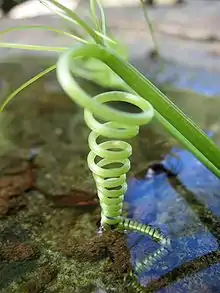Helical growth
Helical growth is the expansion of fungal, algal or higher plant cells or organs leading to a twisted (i.e. helical) cell or organ shape. Helical growth typically results in the breaking of (usually radial) symmetry (biology). Resulting shapes may be left-handed or right-handed. Helical growth can arise naturally (e.g. as seen in tendrils or in twining plants[1]) or artificially by mutation (Arabidopsis thaliana). In many cases, a phenomenon known as tendril perversion is seen, in which a tendril curves in opposite directions at each end, with a transition in-between.[2]

Helical growth of twining plants is based on a nutational movement of stems (circumnutation). When such stems find support this nutational movement may become fixed into a helical winding. Most twining plants show right-handed helices regardless of the hemisphere the plant is growing in.[3]
A missense mutation in the conserved grip1 motif, called spiral3, caused a left-handed helical organization of cortical microtubule arrays, and severe right-handed helical growth. The spiral3 mutation compromises interaction between GCP2 and GCP3, another subunit of the complex, in yeast. In the spiral3 mutant, microtubule dynamics and nucleation efficiency were not markedly affected, but nucleating angles were wider and more divergently distributed. A spiral3 katanin double mutant had swollen and twisted epidermal cells, and showed that the microtubule minus ends were not released from the nucleation sites, although the nucleating angles distributed in a similar manner to those in spiral3. These results show that Arabidopsis GCP2 has an important role in precisely positioning the gamma-tubulin-containing complex on pre-existing microtubules and in the proper organization of cortical arrays.[4]
Helical growth of single cells, as seen in Phycomyces (Fungi) and Nitella (Characeae), is believed to be caused by a helical arrangement of microfibrils in the cell wall. This was suggested by birefringence analyses of cell walls.[5] In Arabidopsis thaliana mutants helical growth is exhibited at the organ level. Mutant analysis strongly supports the idea that cortical microtubules have an important role in controlling the direction of organ expansion in plants.[6] It is not clear how helical growth mutants affect cell wall assembly of Arabidopsis thaliana. Helical growth is the expansion of fungal, algal or higher plant cells or organs that leads to twisted growth of plants [7]
References
- Goriely, A.; Tabor, M. (1998). "Spontaneous helix-hand reversal and tendril perversion in climbing plants". Phys. Rev. Lett. 80: 1564–156. Bibcode:1998PhRvL..80.1564G. doi:10.1103/physrevlett.80.1564.
- Alain Goriely (2013). "Inversion, Rotation, and Perversion in Mechanical Biology: From Microscopic Anisotropy to Macroscopic Chirality" (PDF). p. 9.
- Edwards, W. et al. 2007. The global trend in plant twining direction. Global Ecol. Biogeogr. 1-6.
- Nakamura M, Hashimoto T (2009). "A mutation in the Arabidopsis -tubulin-containing complex causes helical growth and abnormal microtubule branching". Journal of Cell Science. 122 (13): 2208–2217. doi:10.1242/jcs.044131. ISSN 0021-9533. PMID 19509058.
- Roelofsen, P.A. (1965). "Ultrastructure of the wall in growing cells and its relation to the direction of growth". Adv. Bot. Res. 2: 69–149. doi:10.1016/s0065-2296(08)60250-5.
- Hashimoto, T (2002). "Molecular genetic analysis of left-right handedness in plants". Philos. Trans. R. Soc. Lond. B Biol. Sci. 357: 799–808. doi:10.1098/rstb.2002.1088. PMC 1692985. PMID 12079675.
- http://prl.aps.org/abstract/PRL/v109/i12/e128104